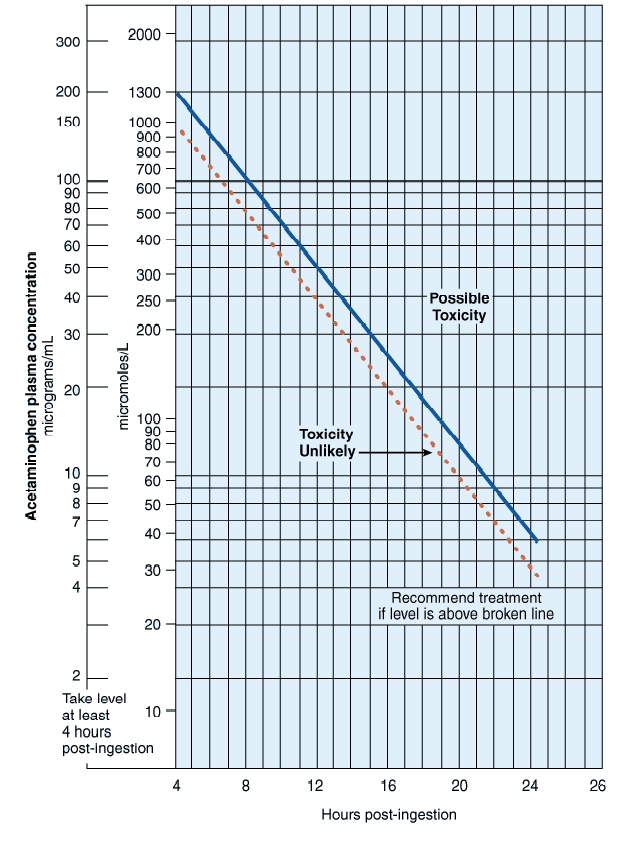Acetaminophen toxicity: Difference between revisions
m (moved Acetaminophen (Tylenol) to Acetaminophen (Tylenol) Toxicity) |
No edit summary |
||
| Line 41: | Line 41: | ||
#Nomogram (see below) | #Nomogram (see below) | ||
##Only indicated for single, acute ingestion occurring <24hr prior to presentation | ##Only indicated for single, acute ingestion occurring <24hr prior to presentation | ||
== Work UP == | == Work UP == | ||
| Line 50: | Line 49: | ||
#PT/PTT/INR | #PT/PTT/INR | ||
#Acetaminophen level: 4 hours post ingestion and repeat in 4 hours | #Acetaminophen level: 4 hours post ingestion and repeat in 4 hours | ||
== Treatment == | == Treatment == | ||
#GI decontamination | |||
##[[Activated Charcoal]] if <3 hr post-ingestion | |||
##[[Gastric Lavage]] if high-morbidity coingestants and <1 hr post-ingestion | |||
# | #N-acetylcysteine (NAC or Mucomyst) | ||
##Wait for level before initiating therapy if level will return within 8hr post-ingestion | |||
##[[ | ##Plot level on nomogram; if acetaminophen level in non-toxic range, NAC not indicated | ||
#[[ | |||
# | |||
##Wait for level before initiating therapy if level will return within | |||
##Plot on | |||
##If level will not return within 8 hrs post-ingestion, give first dose of NAC empirically with suspected toxic ingestion; discontinue therapy if level non-toxic | ##If level will not return within 8 hrs post-ingestion, give first dose of NAC empirically with suspected toxic ingestion; discontinue therapy if level non-toxic | ||
Revision as of 10:34, 7 January 2012
Background
- Recommended maximum total daily dose:
- Adults: 3gm
- Peds: 75mg/kg
- Toxic dose
- >10gm or >200mg/kg as single ingestion or over 24hr period OR
- >6gm or >150mg/kg per 24hr period x2d
- Peak serum levels seen within 2hr
Pathophysiology
- APAP toxic metabolite NAPQI usually quickly detoxified by glutathione
- In overdose, glutathione runs out, NAPQI accumulates -> liver injury
- NAC increases availability of glutathione
Clinical Features
- Stage 1 (first 24hr)
- Mild N/V/malaise
- Hypokalemia (a/w high 4-hr level)
- Stage 2 (days 2-3)
- Improvement in symptoms
- RUQ abd pain
- Elevated transaminases
- Elevated bilirubin, PT (if severe)
- Stage 3 (days 3-4)
- Recurrence of N/V
- Hepatic failure
- Jaundice
- Coagulopathy
- Encephalopathy (esp w/ massive ingestions)
- Renal failure (1-2%; usually after hepatic failure is evident)
- Pancreatitis (rare)
- Stage 4 (after day 5)
- Clinical improvement and recovery (7-8d) OR
- Deterioration to multi-organ failure and death OR
- Continued deterioration
Diagnosis
- APAP level
- Obtain 4hrs post-ingestion
- Obtaining multiple levels is rarely indicated in the absence of hepatotoxicity
- Nomogram (see below)
- Only indicated for single, acute ingestion occurring <24hr prior to presentation
Work UP
- APAP level
- Chemistry
- Metabolic acidos seen w/ extremely large ingestion
- LFT
- PT/PTT/INR
- Acetaminophen level: 4 hours post ingestion and repeat in 4 hours
Treatment
- GI decontamination
- Activated Charcoal if <3 hr post-ingestion
- Gastric Lavage if high-morbidity coingestants and <1 hr post-ingestion
- N-acetylcysteine (NAC or Mucomyst)
- Wait for level before initiating therapy if level will return within 8hr post-ingestion
- Plot level on nomogram; if acetaminophen level in non-toxic range, NAC not indicated
- If level will not return within 8 hrs post-ingestion, give first dose of NAC empirically with suspected toxic ingestion; discontinue therapy if level non-toxic
If toxic:
- NAC
- PO:
- 140 mg/kg PO load
- 70 mg/kg PO q4hr x17 doses additional; dilute to 5% soln
- IV (Acetadote)
- Loading dose 150 mg/kg in 200 mL D5W over 60 min
- Second (maintenance) dose 50 mg/kg in 500 mL D5W over 4 hrs
- Third dose 100 mg/kg in 1000 mL D5W over 16 hrs
- Virtually 100% effective if given < 8 hr post-ingestion; less effective if 16-24 hr post-ingestion
- May still be useful > 24 hr post-ingestion; even with fulminant hepatic failure
- Do not stop when acetaminophen concentrations fall to 0: free radicals are still causing hepatic damage
- In pts who develop hepatic injury, NAC tx should be continued until liver function improves (follow LFT's)
- May require strong anti-emetic (ondansetron 0.15 mg/kg IV, metoclopramide 20-40mg IV) or NGT if severe vomiting
- PO:
- Increase elimination
- Charcoal hemoperfusion
- Also effective in removing acetaminophen
- Not useful in usual clinical circumstances
- Indicated when pt. has fulminant hepatic encephalopathy with significant levels of acetaminophen present
- Charcoal hemoperfusion
- Follow acetaminophen levels q4h, LFT, Coags
- Evaluate potential need for liver transplant: pH<7.25, Cr >2.5, INR >4.5
Disposition
- Psych hold
- Admit
- Pre-school child with ingestions > 200 mg/kg
- Older child, adult w/ingestion >150 mg/kg or a total dose of 7.5 g
- Liver function abnormalities
- Delayed presentation or requirement for NAC therapy
- Discharge
- Asymptomatic pts. w/o need of NAC therapy
The "140" Rule
- Toxic dose is 140 mg/kg
- Give NAC if level is >140 mcg/mL four hours post-ingestion
- Initial loading dose of NAC is 140 mg/kg PO



